Hierarchical Tactile Sensation Integration from Prosthetic Fingertips Enables Multi-Texture Surface Recognition †
Abstract
:1. Introduction
2. Materials and Methods
2.1. Liquid Metal Tactile Sensor Operational Principle
2.2. Microfabrication of Liquid Metal Sensor Mold
2.3. Liquid Metal Sensor Manufacturing Process
2.4. Liquid Metal Injection Process
2.5. Design and Assembly of Fingertip Tactile Sensor
2.6. Robotic System Configuration
2.7. Liquid Metal Sensor Calibration
2.8. Experiment Design
2.8.1. Individual Fingertip Sensors to Detect Texture and Speed of Sliding Contact
2.8.2. Hierarchical Touch Sensation Integration to Detect Complex Multi-Textured Surfaces
2.9. Machine Learning Classification Approach
3. Results
3.1. Liquid Metal Sensors Sliding Across Different Textures
3.2. Detected Speed of Sliding Contact with Individual Fingertip Sensors
3.3. Distinguishing between Different Textures with Individual Fingertip Sensors
3.4. Hierarchical Tactile Sensation Integration to Distinguish between Complex Multi-Textured Surfaces
4. Discussion
5. Conclusions
Supplementary Materials
Author Contributions
Funding
Data Availability Statement
Acknowledgments
Conflicts of Interest
References
- Ziegler-Graham, K.; MacKenzie, E.J.; Ephraim, P.L.; Travison, T.G.; Brookmeyer, R. Estimating the prevalence of limb loss in the United States: 2005 to 2050. Arch. Phys. Med. Rehabil. 2008, 89, 422–429. [Google Scholar] [CrossRef]
- Belter, J.T.; Segil, J.L.; SM, B. Mechanical design and performance specifications of anthropomorphic prosthetic hands: A review. J. Rehabil. Res. Dev. 2013, 50, 599. [Google Scholar] [CrossRef]
- Engeberg, E.D.; Meek, S.G. Adaptive sliding mode control for prosthetic hands to simultaneously prevent slip and minimize deformation of grasped objects. IEEE/ASME Trans. Mechatron. 2011, 18, 376–385. [Google Scholar] [CrossRef]
- Abd, M.A.; Al-Saidi, M.; Lin, M.; Liddle, G.; Mondal, K.; Engeberg, E.D. Surface Feature Recognition and Grasped Object Slip Prevention With a Liquid Metal Tactile Sensor for a Prosthetic Hand. In Proceedings of the 2020 8th IEEE RAS/EMBS International Conference for Biomedical Robotics and Biomechatronics (BioRob), New York, NY, USA, 29 November–1 December 2020; pp. 1174–1179. [Google Scholar]
- Johansson, R.S.; Flanagan, J.R. Coding and use of tactile signals from the fingertips in object manipulation tasks. Nat. Rev. Neurosci. 2009, 10, 345–359. [Google Scholar] [CrossRef] [PubMed]
- Liao, X.; Wang, W.; Lin, M.; Li, M.; Wu, H.; Zheng, Y. Hierarchically distributed microstructure design of haptic sensors for personalized fingertip mechanosensational manipulation. Mater. Horiz. 2018, 5, 920–931. [Google Scholar] [CrossRef]
- Dahiya, R.S.; Metta, G.; Valle, M.; Sandini, G. Tactile sensing—From humans to humanoids. IEEE Trans. Rob. 2009, 26, 1–20. [Google Scholar] [CrossRef]
- Wisitsoraat, A.; Patthanasetakul, V.; Lomas, T.; Tuantranont, A. Low cost thin film based piezoresistive MEMS tactile sensor. Sens. Actuators A Phys. 2007, 139, 17–22. [Google Scholar] [CrossRef]
- Xu, Y.; Hu, X.; Kundu, S.; Nag, A.; Afsarimanesh, N.; Sapra, S.; Mukhopadhyay, S.C.; Han, T. Silicon-Based Sensors for Biomedical Applications: A Review. Sensors 2019, 19, 2908. [Google Scholar] [CrossRef] [PubMed] [Green Version]
- Krassow, H.; Campabadal, F.; Lora-Tamayo, E. Photolithographic packaging of silicon pressure sensors. Sens. Actuators A Phys. 1998, 66, 279–283. [Google Scholar] [CrossRef]
- Pritchard, E.; Mahfouz, M.; Evans, B.; Eliza, S.; Haider, M.R. Flexible capacitive sensors for high resolution pressure measurement. In Proceedings of the 2008 IEEE Sensors, Institute of Electrical and Electronics Engineers (IEEE), Lecce, Italy, 26–29 October 2008; pp. 1484–1487. [Google Scholar]
- Oh, J.H.; Woo, J.Y.; Jo, S.; Han, C.-S. Pressure-conductive rubber sensor based on liquid-metal-PDMS composite. Sens. Actuators A Phys. 2019, 299, 111610. [Google Scholar] [CrossRef]
- Liang, Z.; Cheng, J.; Zhao, Q.; Zhao, X.; Han, Z.; Chen, Y.; Ma, Y.; Feng, X. High-Performance Flexible Tactile Sensor Enabling Intelligent Haptic Perception for a Soft Prosthetic Hand. Adv. Mater. Technol. 2019, 4, 1900317. [Google Scholar] [CrossRef]
- Zou, L.; Ge, C.; Wang, Z.J.; Cretu, E.; Li, X. Novel tactile sensor technology and smart tactile sensing systems: A review. Sensors 2017, 17, 2653. [Google Scholar] [CrossRef]
- Barbee, M.H.; Mondal, K.; Deng, J.Z.; Bharambe, V.; Neumann, T.V.; Adams, J.J.; Boechler, N.; Dickey, M.D.; Craig, S.L. Mechanochromic Stretchable Electronics. ACS Appl. Mater. Interfaces 2018, 10, 29918–29924. [Google Scholar] [CrossRef]
- Park, Y.-L.; Chen, B.-R.; Wood, R.J. Design and fabrication of soft artificial skin using embedded microchannels and liquid conductors. IEEE Sens. J. 2012, 12, 2711–2718. [Google Scholar] [CrossRef]
- Yin, J.; Aspinall, P.; Santos, V.J.; Posner, J.D. Measuring dynamic shear force and vibration with a bioinspired tactile sensor skin. IEEE Sens. J. 2018, 18, 3544–3553. [Google Scholar] [CrossRef]
- Fishel, J.A.; Loeb, G.E. Bayesian exploration for intelligent identification of textures. Front. Neurorob. 2012, 6, 4. [Google Scholar] [CrossRef] [PubMed] [Green Version]
- Abd, M.A.; Gonzalez, I.J.; Colestock, T.C.; Kent, B.A.; Engeberg, E.D. Direction of slip detection for adaptive grasp force control with a dexterous robotic hand. In Proceedings of the 2018 IEEE/ASME International Conference on Advanced Intelligent Mechatronics (AIM), Auckland, New Zealand, 9–12 July 2018; pp. 21–27. [Google Scholar]
- Kaboli, M.; Cheng, G. Robust tactile descriptors for discriminating objects from textural properties via artificial robotic skin. IEEE Trans. Rob. 2018, 34, 985–1003. [Google Scholar] [CrossRef]
- Oddo, C.M.; Controzzi, M.; Beccai, L.; Cipriani, C.; Carrozza, M.C. Roughness encoding for discrimination of surfaces in artificial active-touch. IEEE Trans. Rob. 2011, 27, 522–533. [Google Scholar] [CrossRef]
- Zhang, B.; Wang, B.; Li, Y.; Huang, W.; Li, Y. Magnetostrictive Tactile Sensor Array for Object Recognition. IEEE Trans. Magn. 2019, 55, 1–7. [Google Scholar] [CrossRef]
- Drimus, A.; Petersen, M.B.; Bilberg, A. Object texture recognition by dynamic tactile sensing using active exploration. In Proceedings of the 2012 IEEE RO-MAN: The 21st IEEE International Symposium on Robot and Human Interactive Communication, Paris, France, 9–13 September 2012; pp. 277–283. [Google Scholar]
- Kappassov, Z.; Corrales, J.-A.; Perdereau, V. Tactile sensing in dexterous robot hands. Rob. Auton. Syst. 2015, 74, 195–220. [Google Scholar] [CrossRef] [Green Version]
- Sankar, S.; Balamurugan, D.; Brown, A.; Ding, K.; Xu, X.; Low, J.H.; Yeow, C.H.; Thakor, N. Texture Discrimination with a Soft Biomimetic Finger Using a Flexible Neuromorphic Tactile Sensor Array That Provides Sensory Feedback. Soft Rob. 2020. [Google Scholar] [CrossRef]
- Speeter, T.H. Three-dimensional finite element analysis of elastic continua for tactile sensing. Int. J. Robot. Res. 1992, 11, 1–19. [Google Scholar] [CrossRef]
- Liang, G.; Mei, D.; Wang, Y.; Chen, Z. Modeling and analysis of a flexible capacitive tactile sensor array for normal force measurement. IEEE Sens. J. 2014, 14, 4095–4103. [Google Scholar] [CrossRef]
- Liang, G.; Wang, Y.; Mei, D.; Xi, K.; Chen, Z. An analytical model for studying the structural effects and optimization of a capacitive tactile sensor array. J. Micromech. Microeng. 2016, 26, 045007. [Google Scholar] [CrossRef]
- Zhang, Y.; Duan, X.-G.; Zhong, G.; Deng, H. Initial slip detection and its application in biomimetic robotic hands. IEEE Sens. J. 2016, 16, 7073–7080. [Google Scholar] [CrossRef]
- Shao, F.; Childs, T.H.; Barnes, C.J.; Henson, B. Finite element simulations of static and sliding contact between a human fingertip and textured surfaces. Tribol. Int. 2010, 43, 2308–2316. [Google Scholar] [CrossRef]
- Wang, Y.; Wu, X.; Mei, D.; Zhu, L.; Chen, J. Flexible tactile sensor array for distributed tactile sensing and slip detection in robotic hand grasping. Sens. Actuators A 2019, 297, 111512. [Google Scholar] [CrossRef]
- Kerr, E.; McGinnity, T.M.; Coleman, S. Material classification based on thermal and surface texture properties evaluated against human performance. In Proceedings of the 2014 13th International Conference on Control Automation Robotics & Vision (ICARCV), Singapore, 10–12 December 2014; pp. 444–449. [Google Scholar]
- Araki, T.; Makikawa, M.; Hirai, S. Experimental investigation of surface identification ability of a low-profile fabric tactile sensor. In Proceedings of the 2012 IEEE/RSJ International Conference on Intelligent Robots and Systems, Vilamoura, Portugal, 7–12 October 2012; pp. 4497–4504. [Google Scholar]
- Qin, L.; Yi, Z.; Zhang, Y. Unsupervised surface roughness discrimination based on bio-inspired artificial fingertip. Sens. Actuators A 2018, 269, 483–490. [Google Scholar] [CrossRef]
- Strese, M.; Schuwerk, C.; Iepure, A.; Steinbach, E. Multimodal feature-based surface material classification. IEEE Trans. Haptic 2016, 10, 226–239. [Google Scholar] [CrossRef] [PubMed]
- Chun, S.; Hwang, I.; Son, W.; Chang, J.-H.; Park, W. Recognition, classification, and prediction of the tactile sense. Nanoscale 2018, 10, 10545–10553. [Google Scholar] [CrossRef]
- Cortes, C.; Vapnik, V. Support-vector networks. Mach. Learn. 1995, 20, 273–297. [Google Scholar] [CrossRef]
- Fix, E. Discriminatory Analysis: Nonparametric Discrimination, Consistency Properties; USAF School of Aviation Medicine: Dayton, OH, USA, 1985; Volume 1. [Google Scholar]
- Ho, T.K. Random decision forests. In Proceedings of the 3rd International Conference on Document Analysis and Recognition, Montreal, QC, Canada, 14–16 August 1995; pp. 278–282. [Google Scholar]
- Hopfield, J.J. Neural networks and physical systems with emergent collective computational abilities. Proc. Natl. Acad. Sci. USA 1982, 79, 2554–2558. [Google Scholar] [CrossRef] [Green Version]
- Koh, K.; Kwon, H.J.; Yoon, B.C.; Cho, Y.; Shin, J.-H.; Hahn, J.-O.; Miller, R.H.; Kim, Y.H.; Shim, J.K. The role of tactile sensation in online and offline hierarchical control of multi-finger force synergy. Exp. Brain Res. 2015, 233, 2539–2548. [Google Scholar] [CrossRef]
- Veiga, F.; Edin, B.; Peters, J. Grip stabilization through independent finger tactile feedback control. Sensors 2020, 20, 1748. [Google Scholar] [CrossRef] [PubMed] [Green Version]
- Damian, D.D.; Arita, A.H.; Martinez, H.; Pfeifer, R. Slip speed feedback for grip force control. IEEE Trans. Biomed. Eng. 2012, 59, 2200–2210. [Google Scholar] [CrossRef] [PubMed]
- Rekik, Y.; Vezzoli, E.; Grisoni, L. Understanding users’ perception of simultaneous tactile textures. In Proceedings of the 19th International Conference on Human-Computer Interaction with Mobile Devices and Services, Vienna, Austria, 4–7 September 2017; pp. 1–6. [Google Scholar]
- Østlie, K.; Lesjø, I.M.; Franklin, R.J.; Garfelt, B.; Skjeldal, O.H.; Magnus, P. Prosthesis rejection in acquired major upper-limb amputees: A population-based survey. Disabil. Rehabil. Assist. Technol. 2012, 7, 294–303. [Google Scholar] [CrossRef] [PubMed]
- Resnik, L.; Ekerholm, S.; Borgia, M.; Clark, M.A. A national study of Veterans with major upper limb amputation: Survey methods, participants, and summary findings. PLoS ONE 2019, 14, e0213578. [Google Scholar] [CrossRef] [Green Version]
- Carey, S.L.; Lura, D.J.; Highsmith, M.J. Differences in myoelectric and body-powered upper-limb prostheses: Systematic literature review. J. Rehabil. Res. Dev. 2015, 52. [Google Scholar] [CrossRef]
- Osborn, L.; Kaliki, R.R.; Soares, A.B.; Thakor, N.V. Neuromimetic event-based detection for closed-loop tactile feedback control of upper limb prostheses. IEEE Trans. Haptics 2016, 9, 196–206. [Google Scholar] [CrossRef] [PubMed] [Green Version]
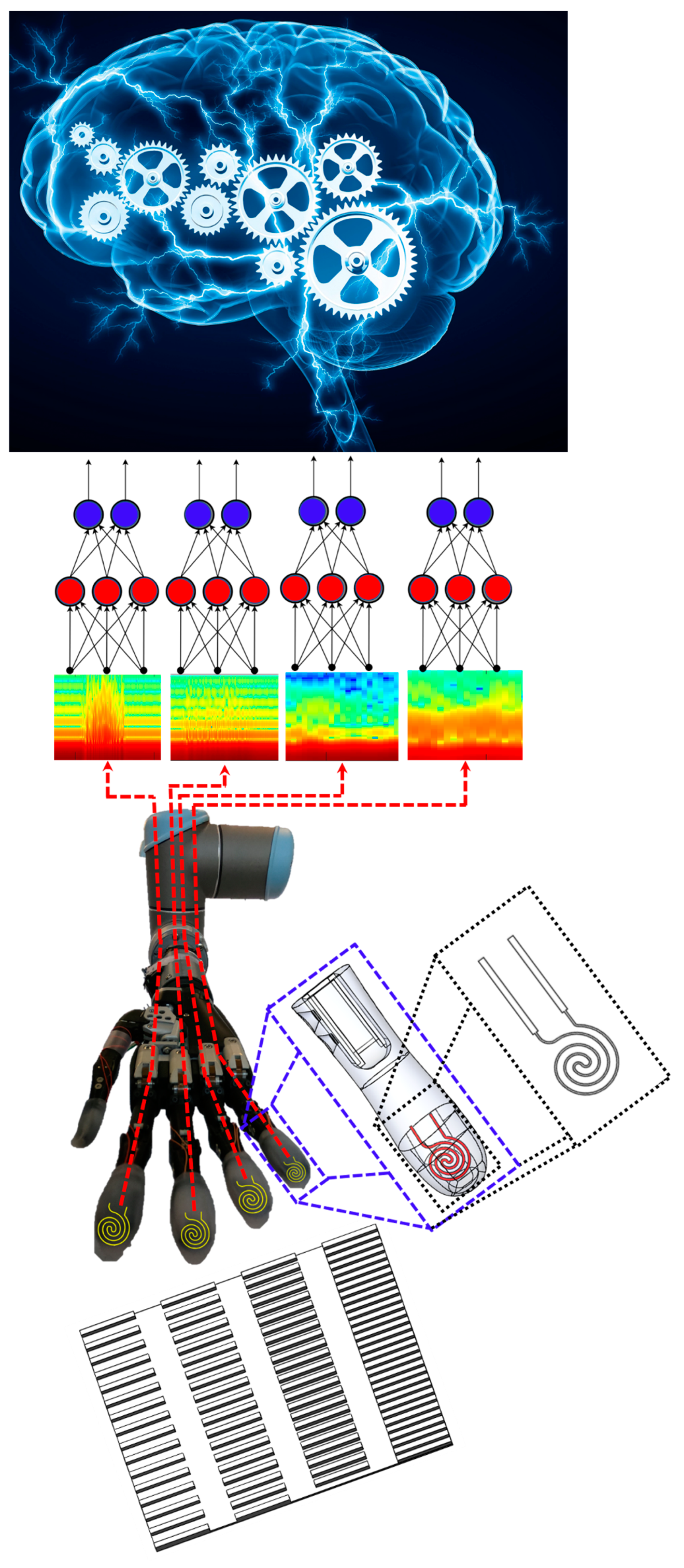


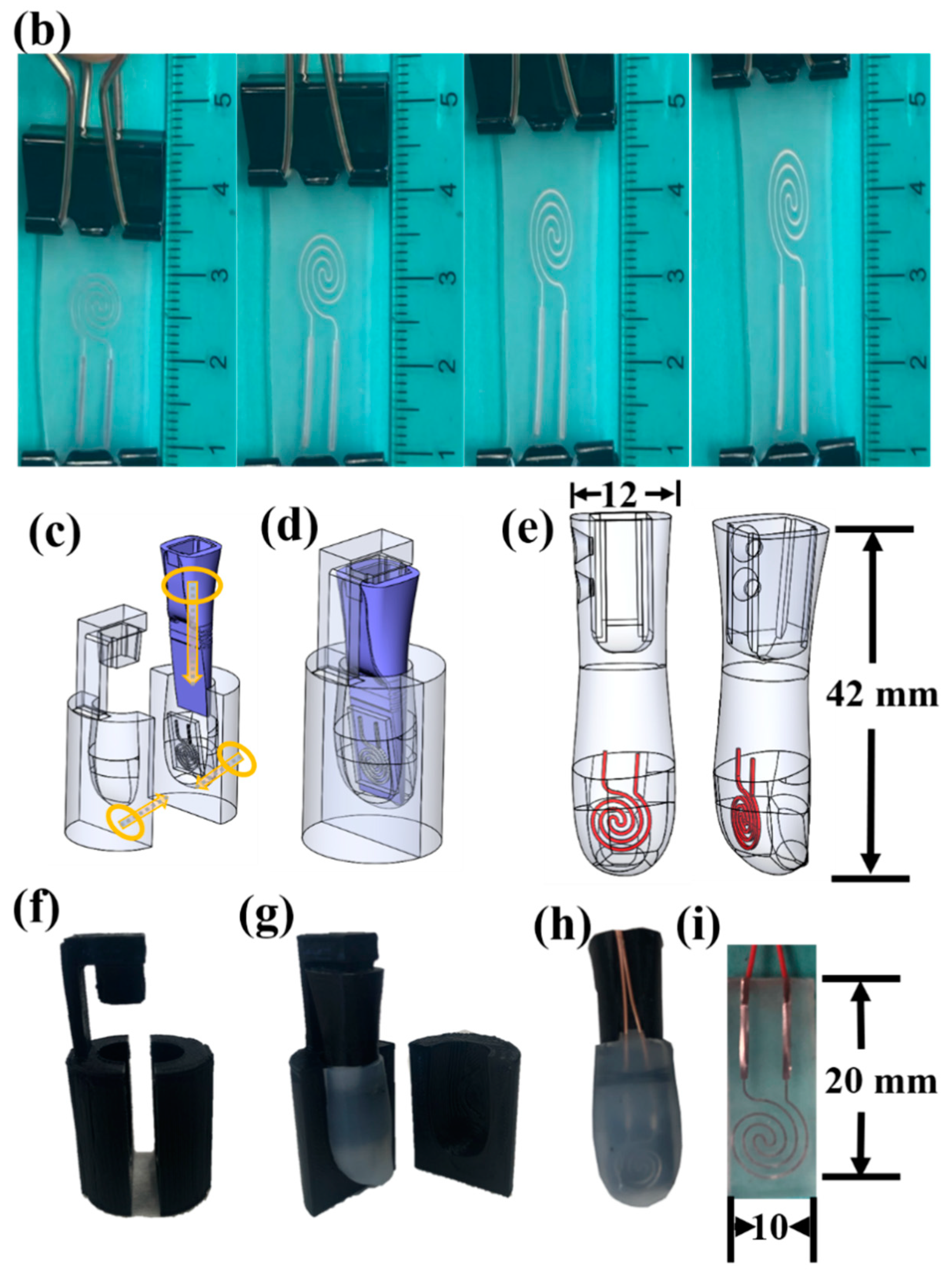
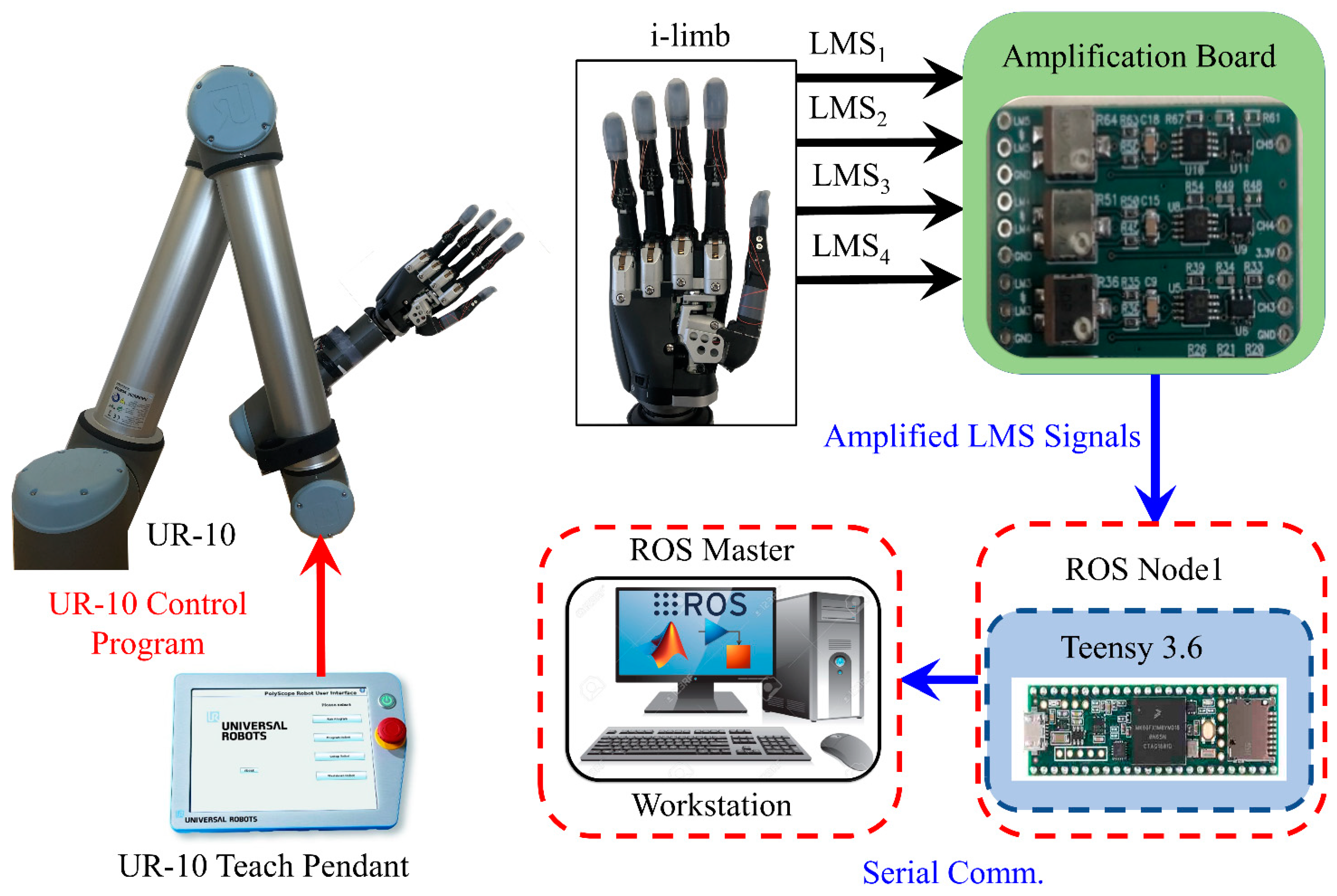
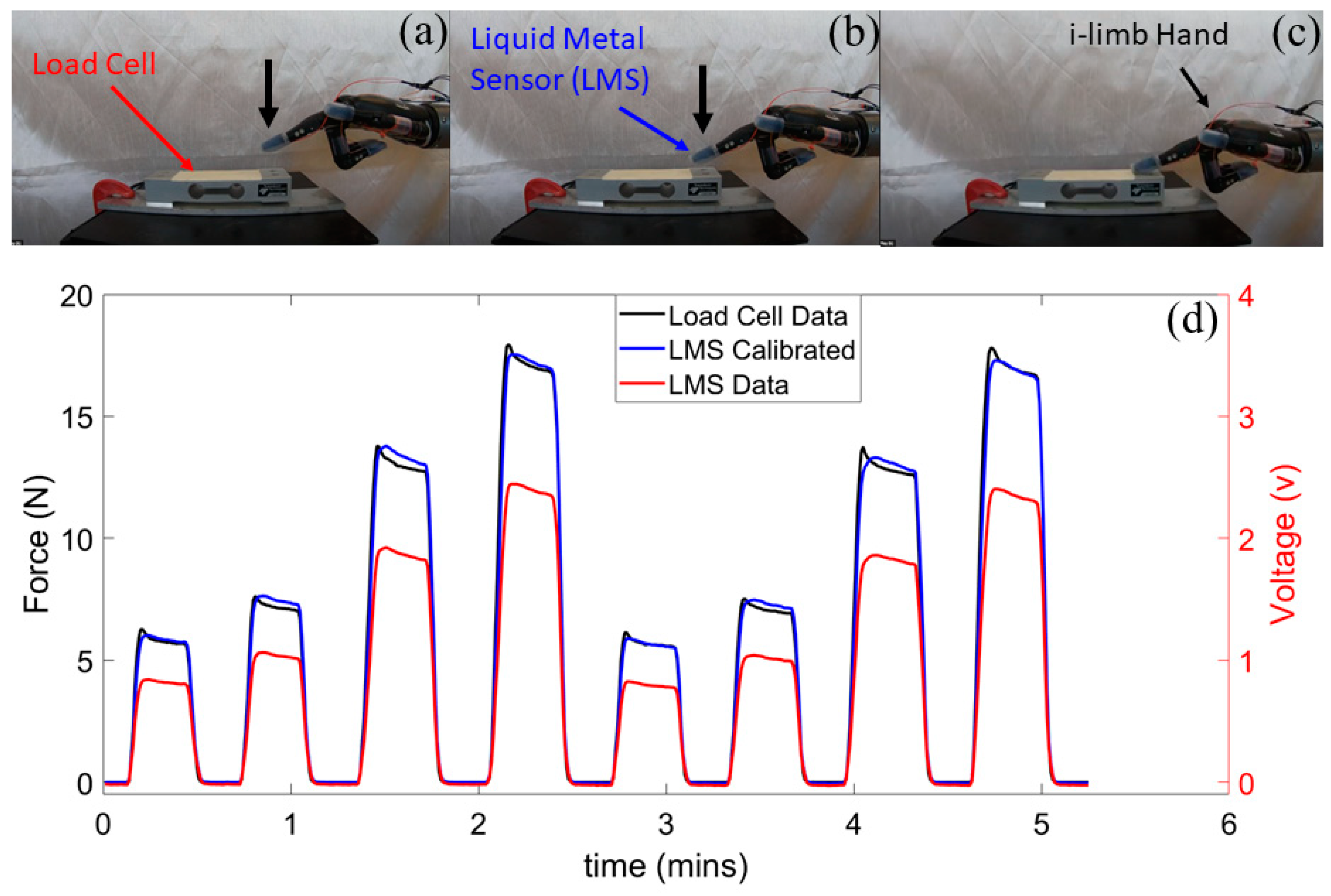
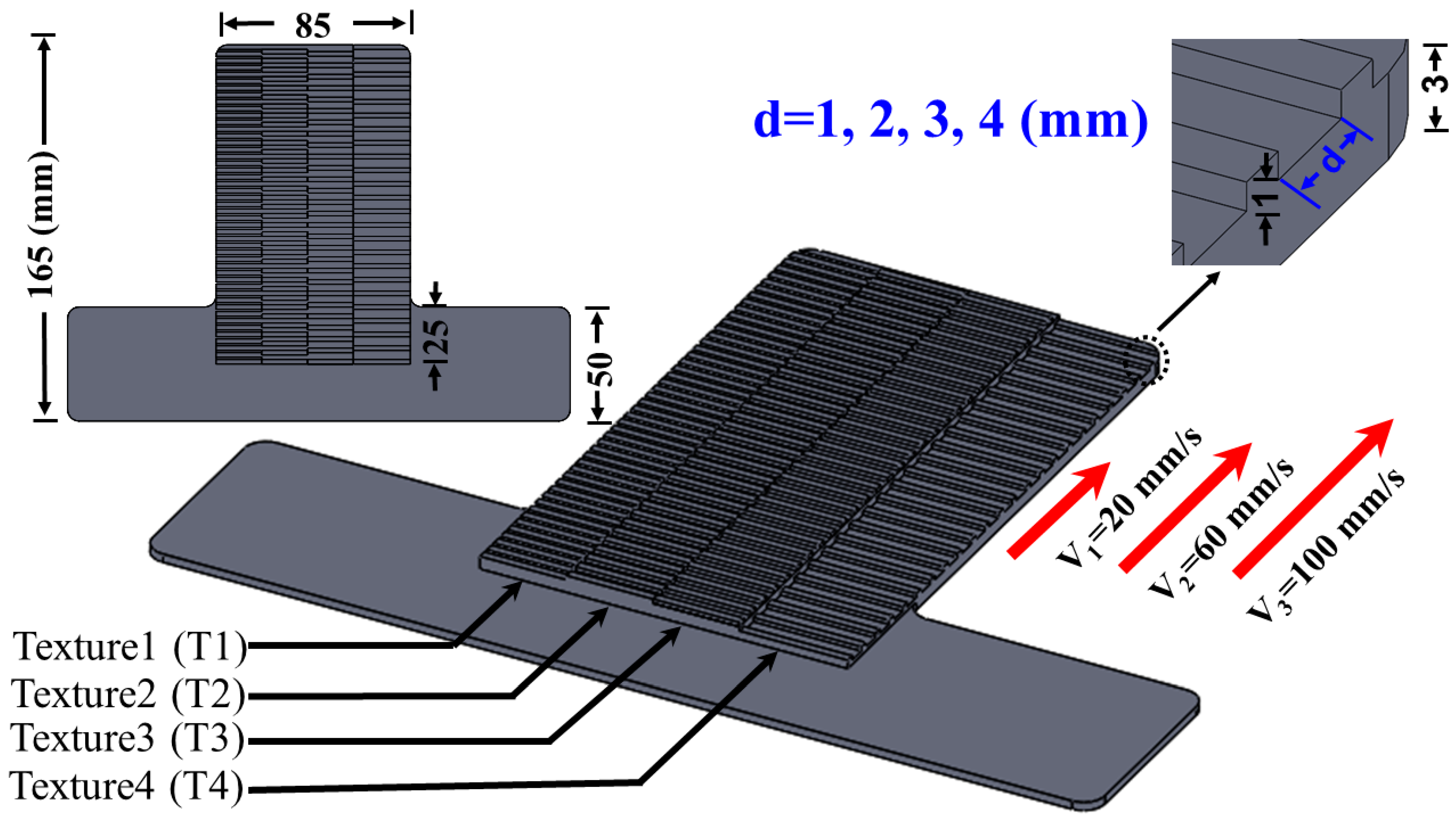
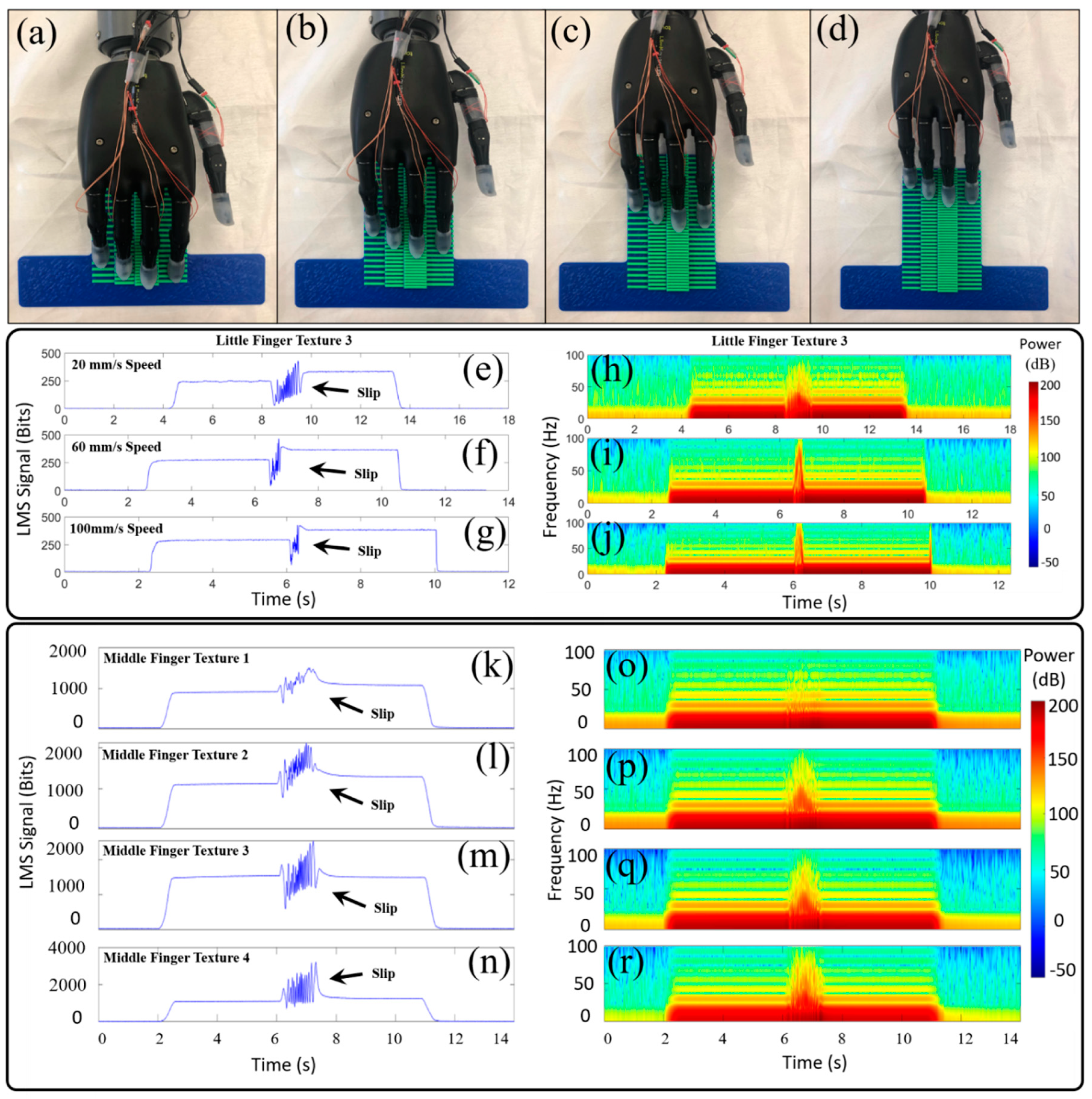
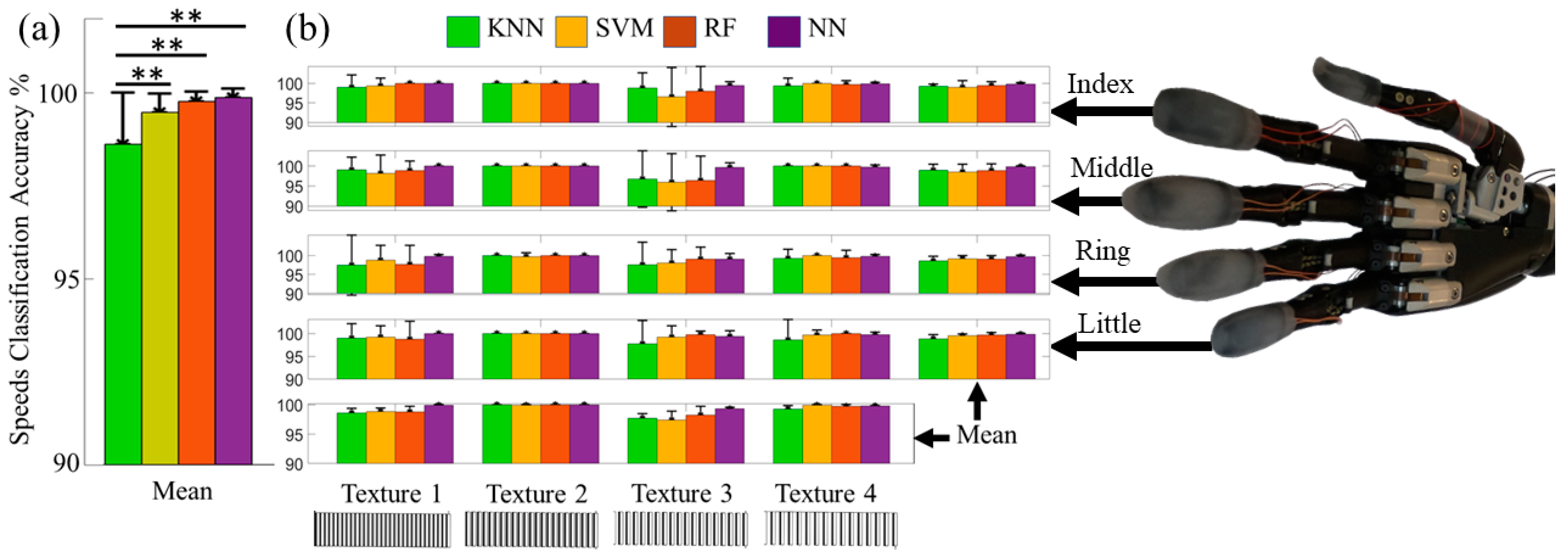
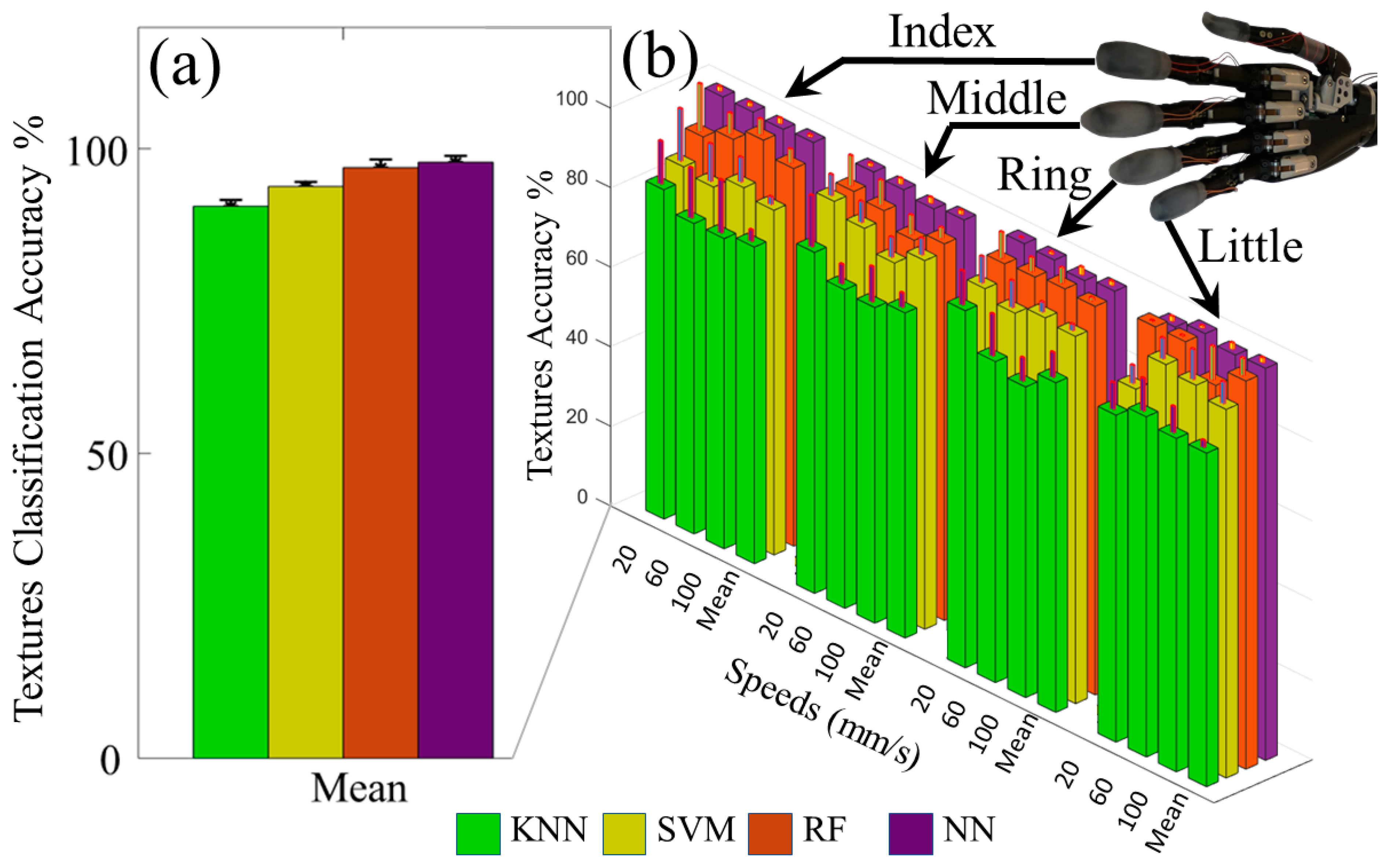

| Classification Algorithms | Accuracy |
|---|---|
| K-Nearest Neighbors (KNN) | 98.5 ± 1.3% |
| Support Vector Machine (SVM) | 99.4 ± 0.4% |
| Random Forest (RF) | 99.6 ± 0.2% |
| Neural Network (NN) | 99.7 ± 0.2% |
| Classification Algorithm | Accuracy |
|---|---|
| K-Nearest Neighbors (KNN) | 90.5 ± 1.1% |
| Support Vector Machine (SVM) | 93.8 ± 0.7% |
| Random Forest (RF) | 96.8 ± 1.4% |
| Neural Network (NN) | 97.8 ± 1.0% |
| Classification Algorithms | Accuracy |
|---|---|
| K-Nearest Neighbors (KNN) | 88.6 ± 5.1% |
| Support Vector Machine (SVM) | 94.3 ± 3.4% |
| Random Forest (RF) | 97.0 ± 2.1% |
| Neural Network (NN) | 99.2 ± 0.8% |
Publisher’s Note: MDPI stays neutral with regard to jurisdictional claims in published maps and institutional affiliations. |
© 2021 by the authors. Licensee MDPI, Basel, Switzerland. This article is an open access article distributed under the terms and conditions of the Creative Commons Attribution (CC BY) license (https://creativecommons.org/licenses/by/4.0/).
Share and Cite
Abd, M.A.; Paul, R.; Aravelli, A.; Bai, O.; Lagos, L.; Lin, M.; Engeberg, E.D. Hierarchical Tactile Sensation Integration from Prosthetic Fingertips Enables Multi-Texture Surface Recognition. Sensors 2021, 21, 4324. https://doi.org/10.3390/s21134324
Abd MA, Paul R, Aravelli A, Bai O, Lagos L, Lin M, Engeberg ED. Hierarchical Tactile Sensation Integration from Prosthetic Fingertips Enables Multi-Texture Surface Recognition. Sensors. 2021; 21(13):4324. https://doi.org/10.3390/s21134324
Chicago/Turabian StyleAbd, Moaed A., Rudy Paul, Aparna Aravelli, Ou Bai, Leonel Lagos, Maohua Lin, and Erik D. Engeberg. 2021. "Hierarchical Tactile Sensation Integration from Prosthetic Fingertips Enables Multi-Texture Surface Recognition" Sensors 21, no. 13: 4324. https://doi.org/10.3390/s21134324
APA StyleAbd, M. A., Paul, R., Aravelli, A., Bai, O., Lagos, L., Lin, M., & Engeberg, E. D. (2021). Hierarchical Tactile Sensation Integration from Prosthetic Fingertips Enables Multi-Texture Surface Recognition. Sensors, 21(13), 4324. https://doi.org/10.3390/s21134324









